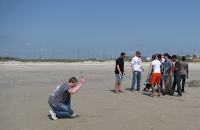After an airliner crashes there is a search for survivors (of which you have about a 1:100 chance of being among) and the search for the ever important in infamous 'black box'. The black box records critical flight data that helps accident investigators determine what caused the crash and if there are problems with the airplane model that need to be corrected. This was the case of the stripping jack screw in the tail of the MD-83 that caused the crash of Alaska Air 261 in 2000. The black box has undergone many transformations over the years, but it has always had to be a durable machine that can preserve data through the dramatic forces of a crash, water immersion, and inferno like fires of jet fuel and airframe materials.
Some of the earliest flight data recorders used photographic film rolls that had lines exposed on them by light reflected of sets of mirrors. The mirrors were deflected different amounts according to aircraft parameters resulting in a 'strip chart' on the film. This was easy to develop, but was only a one time use as the film had to be replaced after exposure. The first data recorders just recorded a few simple channels of data and were common only on test flights due to their cost.
Later black boxes, like the one featured in the video below, used metal strips with the data scratched into the metal by a sharp stylus. These records survived the fire and shock much better than film, but were still single use. Keep in mind this is still all done with 'old fashioned' technology as there was no solid state memory in these days. The next step was voice recording. What were the pilots talking about before the crash?
In the 1950's spy gadgets were the rage in the intelligence community and they required some of the same properties that aircraft flight data recorder designers desired: compact, durable, simple. Wire recording was the answer. Magnetically encode data on a spool of wire and use a ground based playback/decoding system. It wasn't long before both the flight data and the cockpit voice data were being recorded on the same wire reel. This reel could be erased and used again.
Modern flight data recorders and required to store at least 88 parameters by law (US) and they are solid state. There are a few cases where the data has been unreadable to due destruction of the unit, but new units that propel themselves from the crash may solve that problem. The new recorders also transmit a beacon signal making them easier to find for about a month. Some of the smart units are even capable of observing when inputs are changing rapidly and collecting data more often as this is when things are likely to go wrong.
The purpose of this trip through the history of the flight data recorder was not only to show the evolution of a remarkable and very useful device, but to show how engineering problems can be solved without a microchip. Are the recorders now better than those of the film days? Of course, but it required some out of the box thinking to build the mechanical recorders of the early days of aviation.








